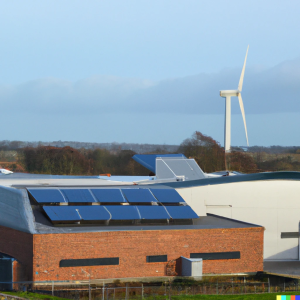Revolutionizing Energy Efficiency:
Embracing the Future with Energy Hubs
The energy landscape is evolving, and at the heart of this transformation lies the concept of energy hubs: innovative solutions born from the pressing need to address grid congestion. As companies find themselves limited by the constraints of an overcrowded electricity grid, the emergence of energy hubs stands as a beacon of hope.
But what exactly are energy hubs, and why are they becoming indispensable in our journey toward a more sustainable future?
Let’s delve into the world of energy hubs, their benefits, and how you can be a part of this groundbreaking shift.
1. Understanding Energy Hubs: A Paradigm for Efficiency
Energy hubs represent a tangible solution to the pressing issue of grid congestion, a challenge hindering the nation’s sustainable progress. These hubs are defined physical areas where parties collaboratively manage contracted power, ensuring they stay within agreed network capacities.
Locally generated energy is consumed within these hubs whenever possible. In cases of shortages, stored energy, such as batteries or heat pumps, is utilized first. Only when necessary, energy is drawn from the grid. This intelligent usage of energy and grid capacity defines the essence of energy hubs.

2. Why the Urgency for Energy Hubs?
An energy hub is necessary because it ensures that energy and grid capacity are used as efficiently as possible. Since grid congestion is currently a major obstacle for companies to electrify and become more sustainable, companies are committed to using the available capacity as efficiently as possible. An energy hub ensures that:
- Companies can plan their expansion ;
- Companies can become more sustainable;
- Companies can implement their electrification plans in the coming years.
- Gives participants the opportunity to take control themselves and not have to wait for the network expansion work.
- New companies can establish themselves and also obtain grid capacity.
- The ambitions of the RESs can be realized.
3. Empowering Business Parks: A Practical Example
Industrial estates exemplify the need and benefits of energy hubs. While many estates have sufficient capacity, bottlenecks occur at the connection points to the upper grid.
When a company needs more capacity, it requests more capacity from the grid operator. In times without grid congestion, a company had extra capacity available through an ATO (connection and transport agreement). This capacity was available 24/7 regardless of whether it was needed 24/7. Because there is grid congestion, the grid operator can no longer deliver capacity in this traditional way (note that grid operators are doing everything they can to increase the capacity of the grid and have doubled investments in recent years).
With an energy hub, the grid operator makes the available capacity available to a new entity (for example an energy cooperative). This cooperative gives members the opportunity to divide capacity among themselves. In this way it is used optimally.
Some examples are:
- Charging electric trucks when the sun shines;
- Installing a battery to charge trucks at night;
- Installing E-boilers to also use locally generated electricity locally;
- Turn industrial processes up or down depending on the amount of available electricity.
In the coming years, many new ways to generate and use energy smartly and locally will be applied to the 3,500 industrial estates in the Netherlands.
4. Starting Your Own Energy Hub: The Path Forward
The National Grid Congestion Action Plan is paving the way for widespread energy hub adoption. Here’s how you can get involved:
1. Organize and Legalize:
Standard contract forms between parties, with the network operators and standard articles of association and commercial contracts will be examined. The overarching legal entity of the energy hub will (as it currently appears) be an energy cooperative. This energy cooperative will have access to the aggregated usage profile of the parties.
2. Enable Control:
When it is clear which parties are participating, it will also become clear which devices only consume and generate energy. These must be able to be read in real time to monitor whether capacity is being maintained. In addition, devices must be able to be controlled safely so that they can be switched off or switched on in the event of shortages or surpluses. The Teleport Gateway has been developed for this purpose.
3. Monitor and Adapt:
Real-time data makes it clear whether the grid operator’s capacity limit is being met. If there is a risk of exceedance, batteries can be used or industrial processes can be scaled back.
4. Collaborative Settlements:
Establish transparent settlement systems, ensuring fair compensation based on shared capacity usage among participating parties.
Want to create an energy hub with Withthegrid?
Learn how Withthegrid and its partners can help realize an energy hub. Fill the form below, our experts will contact you in less than 24 hours.